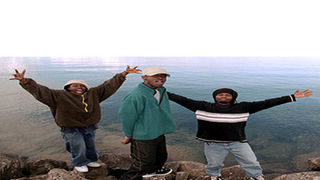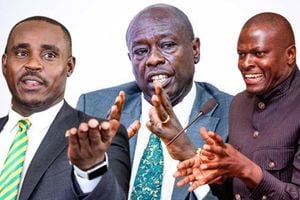
The Kalamashaka trio of Johny, Roba and Kama.
| PoolCulture
Premium
50 years of hip hop: From New York to the city of Nairobi
A quarter of a century ago, a song called Tafsiri Hii introduced hip hop in Kenya, and started an urban wave that has now gone full circle.
Produced by the legendary Tedd Josiah and performed by the Dandora trio Kalamashaka, the opening line of the pioneering hit single captured the angst of urban hustlers, and the jaded, resigned urban youth: “Tafsiri hii! Maisha kule D ni mazii!” (Translate and understand this, life in Dandora is dreary and dreadful).
Kalamashaka’s three members were the woke Kama (Kamau Ngigi), the intellectual introvert Robah (Robert Mtumbai) and the lyrically gifted Johnny Vigeti.
They started off as 3D in the mid-1990s, performing at the iconic but now gone Florida 2000 Discotheque at its star searches. This is where Josiah ran into the talented trio that would “invent” Kenyan hip hop, popularised by radio, especially Capital FM’s Hits Not Homework, and powered by Benson & Hedges’ countrywide and continental concerts.
Also Read: Artists using sounds to showcase Nairobi
By 2003, other urban centres in Nairobi would have their own hip-hop colonies, most notably California in Eastlands, Kariobangi, Githurai, as well as Kayole that budded one of the biggest hip hop rappers of our time, Khaligraph.
Hip hop originated in the Bronx, New York, as an art and culture movement, especially among the immigrants who were faced with rising crime and poverty. Early hip hop, consisted of four major elements: deejaying, rapping, graffiti and break-dancing.
It was in the earliest days popularised by block parties in the Bronx, especially among African-American and Caribbean immigrants. The “street battles” to hip hop riffs would eventually give rise to a worldwide breakdance craze round 1984 (Shaba Doo, Boogalo Shrimp, anyone?) .
The history of hip hop can be divided into three phases: old school, new school and 21st Century. The years running from the early 1970s to mid-80s constitute the old school phase, which is attributed to a number of people such as Clive Campbell (popularly known as DJ Kool Herc) who was the first major hip hop deejay.
Other than popularising rap, he introduced new sounds from his native Jamaica into his music, eventually creating sounds such as drum beats and record scratching. Grandmaster Flash, another DJ, created and improved the needle dropping technique, which prolongs the short drum breaks.
As the old school era came to a close, Rapper’s Delight, a song by The Sugarhill Gang, which was released in 1979, not only popularised rap in the US, but also ushered in new artistes and performers. Other pioneers of old school rap included the Cold Crush Brothers and Kurtis Blow.
The new school hip hop (mid 1980s) boasts of artistes such as Run-DMC who are credited with bringing hip hop to a larger audience through performances on MTV.
They even did a legendary collaboration with Aerosmith that introduced hip hop to White audiences.
They are also known for their unique style of fusing rap with hard rock. Recording label Def Jam’s Beastie Boys, LL Cool J and Public Enemy popularised digital sampling in deejaying, introduced romantic themes to hip hop and propagated social consciousness by including radical black ideologies into rap.
Of course there were also hip hop “miscreants” like the Two Live Crew with their very dirty hip hop hits. Their album, Banned in America, was actually banned in America for a while, until the US Supreme Court ruled that the “lyrics of hip hop, however distasteful to some, are protected under the Freedom of Speech”.
Other artists who emerged around this time included MC Hammer, Vanilla Ice and Will Smith (Fresh Prince). Queen Latifa and Salt N’ Pepper introduced female rappers into the genre. Hip hop then began to expand beyond New York.
For instance, Niggaz With Attitude’s (Dr Dre, Ice Cube and Easy E) album Straight Outta Compton became the first to emerge from West Coast. Their graphic, often violent tales of real life in the inner city gave rise to gangster rap. Other artistes who were prominent around this time included Snoop Dog and Ice T.
Diddy (Puff Daddy), president of Bad Boy Records and a hip hop producer, the excellent Wu-Tang Clan and the Fugees dominated the late 1990s hip hop scene.
Around this time, a rivalry emerged between East and West Coast rappers that would change the face of hip hop by the end of the century.
Hip hop genius Tupac Shakur, who as a teen had studied ballet, acted in Shakespeare plays and wrote poetry, was by the early 90s also an emerging film star. His career was then derailed by a fake sex conviction, landing him in jail.
Bailed out by producer Suge Knight, Tupac hit the world with two huge classic hip hop albums in 1995 and 1996, Me Against the World and All Eyez On Me, and Life Goes On a genius single.
But his deliberate transformation into a “gangsta” rapper and his revolutionary zeal against the East Coast rappers was to lead to the demise of two of the greatest hip hop talents in both coasts.
Artists from the East Coast (New York) would fire salvos at their West Coast (Los Angeles) rivals, who would then hit back hard with dirty tracks.
Tupac’s dig at the Notorious BIG (Christopher Wallace) about sleeping with his wife, Faith Evans, is a case in point. Hip hop potshots turned into real life gunshots, with Tupac, at only 25, being assassinated in the streets of Vegas in September 1996, and Notorious BIG slain the following March, in retaliation.
This was in 1997, and Kenyan hip hop was about to come into its own through Kalamashaka. By the turn of the century, producer Bruce Odhiambo had introduced the hip hop duo K-South, consisting of Doobiez (Abbas Kubaff) and Bamboo, to Kenyans.
Ogopa DJs would unleash the legendary E-Sir and iconic Nameless on the hip hop scene, while Josiah would bring the Gidi Gidi Maji Maji duo with their 2002 national mega-hit Unbwogabble being the revolutionary song that swept Kanu out of power.
Kalamashaka would soon join hands with MC Kah, Wenyeji, Eastlandos, Wakamba Wawili and others to form Ukoo Flani Mau Mau.
The 21st Century hip hop scene in the West has now seen newer names such as Jay-Z, Kanye West, Kendrick Lamar and J Cole, no longer rapping about the streets but more braggadocio.
In Kenya, groups like Wakadinali have kept the hip hop scene legitimate. The group, which consists of Scar Mkadinali, Domani Munga and SewerSydaa, found themselves in the midst of a social media storm over their song Geri Inegi, which was said to have lyrics that promote violence.
Featuring Sirbwoy and released in October 2021, it did not hit until it became a Tik Tok sensation and then a challenge.
“Umbwa!” SewerSydaa shouts, and with this single word, he became a hip hop hit. The title of the song means “another gang” and is about an invasion of a hood by a foreign gang who come with “kiturrdutu and Kibuguduguboom”, coded terms for AK 47 rifles.
In the decadent decade that followed their millennium success, Kalamashaka went into a decline that became a death spin.
Kama eventually left for the US with a wife and kid. Vigeti got into trouble with the law and substance abuse, though he has done long rehabs and even released a single in 2016. As an entertainment writer many years back, I did see my friend Robah struggle with alcohol addiction, which he eventually overcame.
Robert tells me that their Hatufi Leo musical concert at The Mall in Nairobi tonight isn’t a comeback but “the reunion of a family that has dispersed, but then comes together for a great occasion such as the 50th anniversary of hip hop in the world.
He is also grateful to Unkut Awards for recognising Kalamashaka on August 4 with a Lifetime Achievement Award for “pioneering hip hop in the region”.





